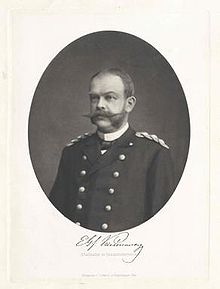Erich von Kielmansegg
Erich Graf von Kielmansegg (born February 13, 1847 in Hanover , † February 5, 1923 in Vienna ) was a senior civil servant and politician in the Austro-Hungarian monarchy . He served as governor of Lower Austria for 23 years and was briefly Prime Minister of Cisleithanien , the Austrian half of the Habsburg Monarchy , in 1895 .
Life
His parents were Eduard von Kielmansegg , Prime Minister of the Kingdom of Hanover and Juliane von Zesterfleth (1808–1880). Kielmansegg grew up in Hanover and Frankfurt am Main , studied in Heidelberg and fled with his family to Vienna in 1866 after the German War . He studied Jus at the University of Vienna and entered in 1870 in the Austrian administrative services and was 1871-73 secretary of Prime Minister Adolf von Auersperg .
From 1876 to 1881 Kielmansegg acted as district captain of the Baden district , which also includes the area of today's Mödling district , later he held this position in the Sechshaus district . From 1882 to 1886 he worked in the provincial governments of the crown lands of Bukowina and Carinthia in Chernivtsi and Klagenfurt . Afterwards he was head of the state police in the Ministry of the Interior as section head. He married Anastasia Lebedewna von Lebedeff (* 1860) in Chernivtsi in 1884.
Kielmansegg was governor of Lower Austria from October 17, 1889 to June 28, 1911 (interrupted in 1895 by his ministerial presidency). He was the "most important" Lower Austrian governor of the era. During his term of office, numerous suburbs in Vienna were incorporated in 1890. He is therefore considered to be the creator of Greater Vienna during the imperial era (not to be confused with Greater Vienna during the Nazi era ). The Danube regulation , the expansion of the Vienna River and the Danube Canal , he ran to vorderster place.
From June 18 to October 2 1895 Kielmansegg was as confidant of Emperor Franz Joseph , Austrian Prime Minister and Minister of Interior of his transitional cabinet. From the outset, his government was intended to run the current business until a definitive government under Kasimir Felix Badeni was installed .
In 1906, a chancellery reform he had worked out came into force, which simplified filing in Lower Austria. This "Kielmansegg chancellery form" was imitated in many crown lands. Sport and tourism as well as the new automobiles were promoted by Kielmannsegg. Politically, he could not prevail against the Social Democrats or the Christian Socials under Karl Lueger .
Kielmannsegg died on February 5, 1923 in his home in the Town Hall Street in Vienna at a pneumonia , his final resting place he found on the Döblinger cemetery in the 19th district of Vienna Döbling.
Fonts
- Walter Goldinger (ed.): Imperial family, statesmen and politicians. Records of the Imperial and Royal Governor Erich Graf Kielmansegg. Publishing house for history and politics, Vienna 1966.
Individual evidence
- ^ Juliane von Zesterfleth on thepeerage.com , accessed on September 18, 2016.
- ^ A b Walter Goldinger: Kielmansegg, Erich Graf von. In: New German Biography (NDB). Volume 11, Duncker & Humblot, Berlin 1977, ISBN 3-428-00192-3 , p. 580 ( digitized version ).
- ↑ a b c d Kielmansegg Erich Graf. In: Austrian Biographical Lexicon 1815–1950 (ÖBL). Volume 3, Verlag der Österreichischen Akademie der Wissenschaften, Vienna 1965, p. 322.
- ^ Erich Graf von Kielmannsegg on thepeerage.com , accessed on September 18, 2016.
- ^ Ernst Rutkowski: Letters and documents on the history of the Austro-Hungarian monarchy . Volume 1: The Constitutionally Loyal Large Estate 1900–1904 . Verlag Oldenbourg, Munich 1991, ISBN 3-486-52611-1 , p. 61.
- ^ Karl Gutkas : History of the Province of Lower Austria . Verlag Niederösterreichisches Pressehaus, St. Pölten 1973, ISBN 3-85326-406-9 , p. 467.
- ↑ Entry on Erich von Kielmansegg in the Austria Forum (in the AEIOU Austria Lexicon )
- ^ Gernot Dieter Hasiba: The emergency ordinance law in Austria (1848-1917). Necessity and abuse of a "state-preserving instrument". Volume 22 of Studies on the History of the Austro-Hungarian Monarchy. Commission for the History of the Austro-Hungarian Monarchy (1848–1918). Publishing house of the Austrian Academy of Sciences, Vienna 1985, ISBN 3-7001-0731-5 , p. 85.
literature
- Kielmansegg, Erich Gf .. In: Austrian Biographical Lexicon 1815–1950 (ÖBL). Volume 3, Verlag der Österreichischen Akademie der Wissenschaften, Vienna 1965, p. 322.
- Leopold Haushofer: Biography about Erich Graf Kielmansegg. Governor of Lower Austria. Unprinted dissertation, Vienna 1948.
- Rudolf Till : Erich Graf Kielmansegg and the expansion of Vienna in 1890. Gerold Verlag, Vienna 1954.
- Klaus Mlynek : Kielmannsegg, Erich Graf von. In: Dirk Böttcher , Klaus Mlynek, Waldemar R. Röhrbein, Hugo Thielen : Hannoversches Biographisches Lexikon . From the beginning to the present. Schlütersche, Hannover 2002, ISBN 3-87706-706-9 , p. 198.
Web links
- Literature by and about Erich von Kielmansegg in the catalog of the German National Library
- Entry on Erich von Kielmansegg in the database of the state's memory for the history of Lower Austria ( Museum Niederösterreich )
| personal data | |
|---|---|
| SURNAME | Kielmansegg, Erich von |
| ALTERNATIVE NAMES | Kielmansegg, Erich Graf von; Kielmansegg, Erich Friedrich Christian Ludwig von; Kielmansegg, Erich von; Kappa, E. (pseudonym) |
| BRIEF DESCRIPTION | Austrian civil servant and politician |
| DATE OF BIRTH | February 13, 1847 |
| PLACE OF BIRTH | Hanover |
| DATE OF DEATH | February 5, 1923 |
| Place of death | Vienna |



